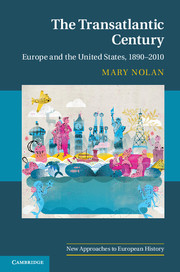Book contents
- Frontmatter
- Contents
- Illustrations
- Maps
- Tables
- Acknowledgments
- Introduction
- 1 An uncertain balance, 1890–1914
- 2 World War I: European crisis and American opportunity
- 3 Ambivalent engagement
- 4 The depression and transatlantic new deals
- 5 Strange affinities, new enemies
- 6 From world war to Cold War
- 7 Cooperation, competition, containment
- 8 Culture wars
- 9 The American Century erodes, 1968–1979
- 10 Renewed conflict and surprising collapse
- 11 A widening Atlantic
- 12 Imperial America, estranged Europe
- Suggested readings
- Index
- References
4 - The depression and transatlantic new deals
Published online by Cambridge University Press: 05 November 2012
- Frontmatter
- Contents
- Illustrations
- Maps
- Tables
- Acknowledgments
- Introduction
- 1 An uncertain balance, 1890–1914
- 2 World War I: European crisis and American opportunity
- 3 Ambivalent engagement
- 4 The depression and transatlantic new deals
- 5 Strange affinities, new enemies
- 6 From world war to Cold War
- 7 Cooperation, competition, containment
- 8 Culture wars
- 9 The American Century erodes, 1968–1979
- 10 Renewed conflict and surprising collapse
- 11 A widening Atlantic
- 12 Imperial America, estranged Europe
- Suggested readings
- Index
- References
Summary
The Roaring Twenties came to an abrupt end with the American stock market crash in the fall of 1929, which ignited a downward spiral of United States bank collapses, home foreclosures, currency instability, and acute price deflation. As the financial crisis spread to the real economy, production dropped precipitously, millions were thrown out of work, businesses closed, farmers went bankrupt, and confidence evaporated. America ceased to be the exceptional exemplar of unprecedented prosperity and the alluring, if disturbing, model of modernity that it had been. And it could no longer aid European economies, which lurched into crises that devastated agriculture, industry, and finance and destroyed the tenuous political and social stability of the mid and late twenties. Transatlantic economic conflicts and political tensions multiplied. Only the Soviet Union remained immune from the ravages of the depression, but the growth and modernization achieved through forced industrialization and collectivization proved enormously socially disruptive, politically divisive, and, for many, fatal.
The depression was not the final crisis of capitalism, as many on the communist left hoped and initially predicted. But it was, in the words of the economist John Maynard Keynes, “the greatest catastrophe due almost to entirely economic causes of the modern world.” The depression destroyed the institutions, ideas, and networks that had structured transatlantic relations. Laissez-faire ideology, self-regulating markets, and the noninterventionist liberal state were called into question. Globalization, already slowed by war, economic turmoil, and political restructuring in the 1920s, virtually stopped, as the gold standard collapsed and trade and capital flows diminished significantly. By 1931 Montagu Norman, governor of the Bank of England, feared that “unless drastic measures are taken to save it, the capitalist system throughout the civilized world will be wrecked within a year.”
- Type
- Chapter
- Information
- The Transatlantic CenturyEurope and America, 1890–2010, pp. 104 - 130Publisher: Cambridge University PressPrint publication year: 2012

